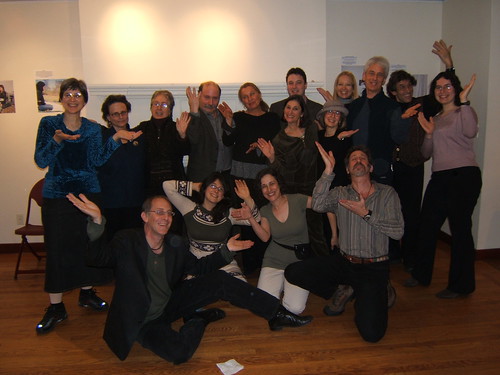Yiddish Dance Symposium
NYC, 9 Dec 2007
Defining Yiddish Dance: Secular, Sacred, Borrowed and Transformed
Notes by Ari Davidow, with help from Helen Winkler and Judith Brin Ingber
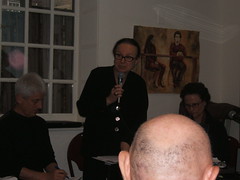 Notes are much paraphrased. So, what I write is what I interpret and may not be quite what the speaker's intended. Apologies. Where the mistakes are egregious, I hope people will let me know so that the record can be corrected. This narrative continues from that bare intro, typed at the event, back on December 9.
Notes are much paraphrased. So, what I write is what I interpret and may not be quite what the speaker's intended. Apologies. Where the mistakes are egregious, I hope people will let me know so that the record can be corrected. This narrative continues from that bare intro, typed at the event, back on December 9.
Welcome
\Michael (Michael Alpert), Zev (Walter Zev Feldman), BKG (Barbara Kirshenblatt-Gimblett)
BKG: (moderator): A landmark day focused entirely on Yiddish Dance
Zev: It is not easy being a self-researcher—studying the tradition that you, yourself practice. When I started studying klezmer music 30 years ago, we were sceptical. Then Mark Slobin, with whom I studied, spoke of revivalization, not just revival—that klezmer music was meeting some needs within the Jewish community and wasn't just reviving for a short time, but was becoming an evolving part of the Jewish community again. Now, I look at Yiddish Dance I wonder if the same may be true. [Gives example from his own research with the community we know as "whirling dervishes" in Greece.]
Michael: This event began as a gleam in the eye of myself and Erik Bendix 10–15 years ago. Today is an attempt to raise questions and see where we are. [repeats in Yiddish, then breaks into song to convey the excitement and ceremony.
1st session: Defining Yiddish Dance
 Zev presents first: It is a bit difficult talking about something that doesn't really have a name. I often talk about Eastern European Jewish Dance. In Israel I talk about Ashkenazic dance. It is also called Hasidic dance. And we have settled, for now, on "Yiddish Dance." On the basis of musical material, this form of dance was in place by mid-19th century. Found a reference in a document in 1674 mentioning Jewish Dance in Poland, but then almost nothing until the 19th century.
Zev presents first: It is a bit difficult talking about something that doesn't really have a name. I often talk about Eastern European Jewish Dance. In Israel I talk about Ashkenazic dance. It is also called Hasidic dance. And we have settled, for now, on "Yiddish Dance." On the basis of musical material, this form of dance was in place by mid-19th century. Found a reference in a document in 1674 mentioning Jewish Dance in Poland, but then almost nothing until the 19th century.
Some Jews did not accept the Hasidic tradition; the Misnagdim didn't dance? danced differently. There were significant changes after the first World War. I was indoctrinated into dance by my father, born in 1898 in a shtetl in Besarabya, and Dave Tarras, born a year later in the next shtetl over.
After the second world war, Jewish dance moved to Israeli dance. So, we look back to the people before we became "hora-ified", and just before that, of course, we were "bulgarized."
Most of our documents come from southern areas in eastern europe, but it seems as though dance principles were common throughout the area:
- There was a Jewish gestural language, a body language.
- There was preservation of archaic western european dance patterns. In the 18th and 19th centuries, Jews went out of their way to learn new patterns
- Selective borrowing of dance patterns from neighbors—Moldavian? Greek?
- There was a separation of a secular and a mystical devotional aspect. This is similar to Turkish custom where some tribes have both secular and mystical folk dance traditions.
We have clear connections between music and a number of different dance forms. When this exists, it is usually a borrowed dance form. Forms change; music is often the same.
On the macro level, we are talking about dance figures, patterns. On the micro level, we talk about gestures, small movements of the body. The steps could be documented from western, eastern europe. But the music, and those gestures—the dance "ornaments" are what was unique.
What were these gestures expressing? In writing about this I began to think in terms of oppositionals—you are often aware of what you are expressing, and also of what you are NOT trying to express.
Basically we have 3, 4 ideas: There is a circle, there are contra formations, there are couples, and we have the solo. In Jewish dancing couples don't have an integral relationship. In Jewish dancing, the couples don't necessarily touch (?). From responsa we know that Jews were still doing couples dancing in Germany in the 15th century. In Eastern Europe the movement toward couples dancing became stronger in the 16th and 17th century, just as the Jews were rejecting the 'couple' formation. Jews and Gentiles are moving in opposite directions here. In Jewish dancing, there is relating, but not touching—at most, Jews will connect using a handkerchief.
[we see video—Bronya Sakhina and Ben Bayzler, recording by Michael Alpert in the '80s
in the video we see couples of the same sex dancing and touching, but couples of opposite sexes do not touch]
[Zev, describing what we have just seen] Note how the dance patterns morph. No names, per se, just different formations.
Zev talks a bit about the evolution of dance styles. Unlike the case in say, Balkan communities, not all Jews in the village had to be excellent dancers. There were professional dancers, but they were less common. The professional dancers would perform at weddings and were paid higher than other musicians.
One respondent talking to Zev told about a professional dancer, "He would dance the way our grandfathers danced".
Solo dancing did lead into a kind of professional specialization.
Men and women also have different gestures. In general, there is a distinction between the upper body and the lower body. The Hasidic rebbes made a big deal of the upper body, and in fact, the older writings do show that this is a traditional Jewish distinction. Fancy footwork is not a big deal in Jewish dancing.
Older folks and younger folks dance differently. Tempo, also, is crucial. "To play a fast tempo for an older person was an insult—they were to dance at a 'dignified' tempo." there could be a lot of agility in a slow tempo.
There could be proud or humorous ways of standing. Angry, entreating, beseeching ways of standing. Differences of hardness/vulnerability; Inward-looking dances could also be a bit erotic. Jewish dancers of Zev's father's generation could also express vulnerability in dance.
The most famous of Jewish expressive dancers is the Broyges Tanz. There is a wonderful description in Boyarin/Kugelmas' "From a Ruined Garden."
[Zev ends with some observations from Dave Tarras. First, a bit of the 1st track of his and Andy Statman's groundbreaking "Jewish Klezmer Music" from 1979. When we asked Dave about the recording, he said, "very nice, very nice, but the tune should "bettle" (beg) a ittle more." what did he mean? Then we hear a Shloimke Beckerman recording. Beckerman is playing at 129; we were playing at 135. Nowadays that is considered the same, but Tarras could hear the difference. To help them understand, Tarras got up and danced. To conclude, Zev puts on the Beckerman performance, and dances for us.
Respondent: LeeEllen Friedland
You know, by the standards of that age, the Beckerman version of the dance was really fast. Yours' and Andy's is hugely faster!
The core of Eastern Jewish Dance is about being in dialogue with music.
Morphing—'couple' dance or 'circle' dance—it's not an item, it's a way of moving that fits the moment and the people dancing. As Zev said, people moved back and forth, morphed between forms.
For a musicologist (not an anthropologist) Zev does a pretty good job of capturing that.
How did dance tradition get here? Everyone had at least part of the knowledge—some song, some memory. It isn't just the dance—it's the music, the social customs, the gestural language. But, this is not like playing a clarinet. "Ornament" is the wrong term for the gestural embellishments, rather, these are expressions of our individual and cultural gestural language.
BKG: notes work of David Efron (e.g, Gesture, race and culture;: A tentative study of the spatio-temporal and "linguistic" aspects of the gestural behavior of eastern Jews and southern Italians ... conditions (Approaches to semiotics), published by Mouton, 1972) on Jewish dance gesture (compared to Italian)
Jill Gellerman: Mention importance of seeing from dancer's perspective, not just from the musicologists.
BKG: We have a rich record of music in this tradition, and such limited dance material to work with.
Mark Slobin: "We could never finish a sher because a fight always broke out"—the point being primacy of event, and the wedding as a locus is so stylized vs. teenagers getting together or other events. In this tradition, the epicenter is the wedding, and it is the wedding that preserved this tradition in the US far longer than it might have. Also, what percentage of performed dance was at formal events?
Zev: I'm giving a paper on this in Toronto next week on "the wedding". Jim Loeffler's masters thesis is about the wedding in the US and there is almost a total break between wedding in Europe and wedding in the US. The whole ethos of the Ashkenaz wedding as it developed over 300 years is a whole weird event, totally different from the surrounding cultures.
from audience: "Sadness before the khuppah"—in orthodox weddings, at the bedeken, there is joyous dancing by men.
Zev: This is America....
BKG: It's hard to generalize—different customs, different times.
Analysis of film and video documents
Michael Alpert, Eric Bendix, Steve Weintraub, Zev Feldman
Michael: I want to underscore this idea of cultural unity in eastern european Jewish culture. Every aspect, to me, of Yiddish culture, contains within it a "nutche", all of the cultural dna. [Refers to handout of images showing Jews dancing as a catalog of some of that dna.]
We talk about a 'present' of our personal experience. There is no dividing line that separates past from present. I am also optimistic.
Much of what we have to talk about is based on observation. I have often thought of "I should have videotaped that" but we didn't have access to affordable technology back then. But there is some documentation. There are lots of videos from organized events such as KlezKamp, KlezKanada, as well as from other events. Yiddish films are another source. Some are quite choreographed. Others contain much more spontaneous dancing.
Particularly important is the film "Uncle Moses," "Fishke de Krumer" (fishl the lame), "Yidlm mitn fidl", "Jewish luck." There are also home movies (also movies made by landsmanshaftn during the pre-war period, some of which are archived at YIVO. These date from the beginnings of popular accessible technology, beginning in the 1930s, but especially over the last 20 years. Video documentation of weddings, especially from recent emigrants from the former Soviet Union.
Quote from Bronya Sakhina: "I hold you by the hand, but I am dancing accoridng to my own rhythm and my own preference."
[video of Bronya Sakina, 1910-1988. "Definitely the most grounded person in the room"
more video—from the Bronz, of Ban Zayzler in LA. Ben, "you dance so that God will see" and several more examples. (Can we get these on the web? ari)]
Zev: [Catskill Honeymoon clip&#mdash;a parody (very similar to gestures used by Jennifer Grey on one of the late night shows singing one of her father's songs—Davy Crockett? ari)]
This is a great example of how language gesture becomes dance gesture. Note also the tempo. Not fast.
Then Zev shows a clip from "the Dybuk" also very stately, then speeding up for the beggar's dance. Interesting contrast back and forth between the slower, stately tempo for the rich women [these were not subservient people—their upper body movements are expansive]/fast, undignified tempo for the beggars [exuberance a sign of poverty].
[dialogue after the dybuk clip between Zev and Felix Fibich, husband of the woman who choreographed that scene. In this case, the choreography was close to what had been observed—at one point Felix shows a gesture, one hand wide, the other behind the head, "we asked, why this gesture? 'I am trying not to lose my yarmulke!'"]
SW: Shows a clip of hasidic rebbee, exhorting his followers to feel the music. His arm gestures are exhortation. Mentions that YouTube and Google Video have a lot of Yiddish Dance videos. He shows "Nikelsburger rebbe".
[Zev points out that this is a very modern tempo]
SW: I want to talk about the knee. Dancing from the knee up is very important. [Shows some clips of dancers doing a sort of skipping step which he feels is part of the Lithuanian style.]
He concludes with a very modern hasidic wedding showing both the individual improvisation and the lines of facing dancers approaching, retreating.
BKG: One question we want to ask ourselves about the dances we learn from older experts is how much those movements were already learned or influenced by movies and theatre.
Felix Fibich: Jews prayer through movement. I learned from kheder. We didn't invent the movements. We picked up from people. When I choreographed, I just had to go back from childhood, how we davened—it was the influence of the Jewish alphabet—every Jewish letter is like a Jewish image, and we subconsciously started inventing these dances of Jewish letters. Arms are not just flug, but almost at an angle, imitating letters.
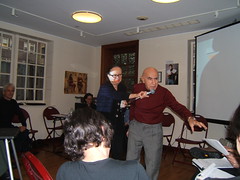 [He dances "Shalom Aleikhem" at the request of someone who knows him.
He leans, his arms wide, his large hands shape his words. He says, 'this is how a Jew talks' and shows more movement, more variation, dancing with his body, with his hands. BKG follows with mike to catch his words.]
[He dances "Shalom Aleikhem" at the request of someone who knows him.
He leans, his arms wide, his large hands shape his words. He says, 'this is how a Jew talks' and shows more movement, more variation, dancing with his body, with his hands. BKG follows with mike to catch his words.]
LeeEllen: one point to notice is that there is a broad continuum of Jewish Dance. No one person can speak to it all, demonstrate it all.
We need to remember to be aware of the temptation to conflate political boundaries/periods with what we observe, "this is Lithuanian…."
Important also to keep separate our descriptive language, from our interpretations. What we see may have many meanings.
BKG: Also pay attention to iconographic conventions (such that we show dance by raising a foot—if you see someone standing in two dimensions, you don't see motion.)
Helen Winkler (HW): I've heard from a respondent in Meah Shearim who talks about how older traditional forms are dying out—people don't have time to do the old forms any more. Interesting in the light of discussions about changing tempos over time and their speedup.
[break for lunch]
Sher and Contra-Dance
Steve Weintraub, Michael Alpert, Zev Feldman
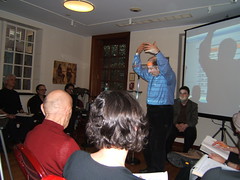 Zev: A sher is a dance w/four couples. It survived into the 1960s, and one of my earliest memories from childhood is of relatives dancing the sher. The sher was so popular that even non-Jews learned it. Although manifestly European, it is widely known as a "Jewish" dance, and it has existed long enough that we can actively research it.
Zev: A sher is a dance w/four couples. It survived into the 1960s, and one of my earliest memories from childhood is of relatives dancing the sher. The sher was so popular that even non-Jews learned it. Although manifestly European, it is widely known as a "Jewish" dance, and it has existed long enough that we can actively research it.
Beregovski, 1937 wrote a long piece about the sher. Zev followed up and realized that Beregovski was on a wild goose chase. B. felt that this came from Germany and was Judaicized. Feldman disagrees.
But, Beregovski does point to an important fact—that the sher is only danced to Jewish music. It is not danced to non-Jewish music.
[There are only a few tunes for sher and all places had it. First Zev plays a baroque-music-sounding recording, then Dave Tarras' definitive "Russiche Sher."]
Referring to Tarras, Zev says, "that's the tune I was brought up with."
So, he says, this is interesting. Maybe 5% of the corpus of the sher has a baroque corpus; 95% is Jewish music. The form of the dance is clearly German Contradance. So, why did the Jews preserve the dance, but not the music? And, in fact, they dance the sher in a Jewish way, not a German way. In one of our earliest references to Jewish dances, a 1904 article, there is reference to the sher—but in the late nineteenth century, this is apparently a "dance of the girls."
By the 20th century, the sher is an important dance of the Jewish wedding.
In Zev's father's village, they danced both sher and quadrille—the latter to non-Jewish music.
Zev feels that B. was mislead. That the name of the dance evolved, so that it was later called "kreuztantz", and that Jews retained the older name, "sher," possibly because they avoided things that incorporated "cross" in the name.
We don't know how Eastern European Jews got the dance. Perhaps it was learned by merchants going to Germany, or merchants fleeing persecution in Europe who came East. Possibly via colonists, and also possibly via Polish aristocracy.
The non-Jewish dance closest to our sher is the Galizian Kreutzpolka, but Galizianers don't do the sher. So, adding it all up, it is most likely that the kreutzpolka and sher have common ancestors—Jews didn't learn the kreutzpolka.
We know that Jews in Germany danced couple dances well into the 17th century (which we know because rabbis wrote responsas against this!). B. notes that in the 19th century, only unmarried girls danced it in _____? Bessarabian Jews didn't even require handkerchiefs and it was a couples dance, perhaps because they never got the pietistic culture that was popular in other regions.
The sher is an Ashkenazic folk response to this pietism? We know that the sher goes back a ways, because by 1820s the sher had fallen out of fashion in Germany and the Quadrille had taken over, so after that point, it couldn't have made its way into the Jewish community—it had to be present earlier.
Michael: In my experience, most people make some reference to the idea of "moving around". Most people will say something about "cutting" or "cutting across" as their etymology of the word, "sher."
The sher is almost a metaphor for eastern european jewish culture. It all comes together in sher. It is a metanym (Zev's term for what Michael just said). It is one of the best examples of Judaizing non-Jewish dance elements. It is one of the few Jewish dances learned by Jewish neighbors and identified as a Jewish dance. It is interesting that this Jewish-nonJewish sharing happened so extensively in Besarabye, one of the most recent Jewish settlements in the East.
The sher also embodies dynamics within the Yiddish world. Within the sher, more than in any other Jewish dance, there is a role for individuals, a role for couples (although 'couple' can be ephemeral in Jewish dance), and a role for the group.
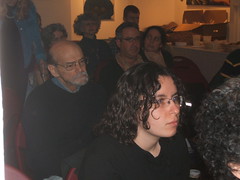 In Europe it would appear that all musicians describe the sher less like an American square dance, danced by a room full of people. The sher was danced only by one set of people (8) at a time. The sher also has a tradition of fighting as to who had the right to buy the next sher.
In Europe it would appear that all musicians describe the sher less like an American square dance, danced by a room full of people. The sher was danced only by one set of people (8) at a time. The sher also has a tradition of fighting as to who had the right to buy the next sher.
[we watch a video of Bronya Sakina, whose style comes from Podolya, southern Ukraine, Besarabye]
[In response to a question: "The sher is often a women's dance, especially in hasidic culture"]
So, how do we get from a women's dance to "bloody sher"—in many regions it had become a mixed dance, especially in secular culture. The sher also remained popular with secular left-wing groups.
[video of 1987 oldsters event, primarily danced by older folks. by then it was typical of the sher to end with a snake figure.]
Although the "Russishe sher" became the dominant sher tune, the Philadelphia sher never changed in those ways. "Rusish" meant "Ukrainian" to most Jews.
Zev: I have reason to believe that the sher had disappeared in some regions of Poland by the 19th century.
To Austrian Jews, this was the "Rusiche sher," therefore.
SW: The one other 18th century dance done in hour-long sets was the minuet.
In 18th century Europe the fun dancing was this style of dancing (sher imporvisations). I see two types of sher from what I have seen of collections. In the first, the leader will trade places with another parnter. Versions still exist in Scandinavia. Other types, an individual goes out, does a little "shining" and then returns to the group.
I suspect that this is something that becomes like a freilachs with partners.
Some of these types of sher require heterosexual couples. Unlike called dances, people have different fluidity. But in these cases, perhaps the music, and the sense of "this many measures" gave the cues as to what to dance when.
Philadelphia sher, the one with the fistfights, is an example of that "shining" style. As the dance goes on, there are fewer and fewer cues as to where you are. So, I'm wondering if that disconnect with the music helped lead to the fights.
What is curious is how what people now remember in the midwest in many places is that "snake dance" ending to the sher—the tail is all that is remembered of the dog!
Questions
LeeEllen: Almost every other part of the sher can be done in other dances. So, what is the sher? Maybe the reason it is considered a Jewish dance is because it pulls all of these other Jewish elements together?
Are we reading to much into the way these are codified?
[As if to prove this last question, several people speak up about "shers" they learned as children that were different from the "sher" as described by the various speakers.]
[Curious thought comes to mind. Elizabeth Eisenstadt, writing about the impact of print on culture, notes that people began reading about their regions as described in books, and regional differences between more accentuated. Today, with so many modes of feedback, I wonder if we have lost the ability to isolate ur versions of anything, and instead are noting amalgams affected by who knows what—this applies to "traditional" Sephardic, especially "from Spain" song as much as to the "sher"]
Interaction with Co-territorial dance
Michael Alpert, Irka Balan, Eric Bendix, Zev Feldman, Demetrios Tashie
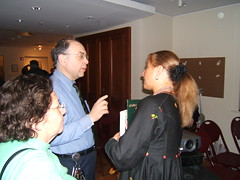 Irka: I have fond memories of growing up with other kids from a number of traditional cultures. My parents came from the Ukraine and settled in Winnipeg. We grew up with language, faith, culture. In the 1950s we grew up not with knowledge of pioneer dances, but with study of stage dance brought from the Ukraine. We had music to follow, a curriculum to follow, steps to learn.
Irka: I have fond memories of growing up with other kids from a number of traditional cultures. My parents came from the Ukraine and settled in Winnipeg. We grew up with language, faith, culture. In the 1950s we grew up not with knowledge of pioneer dances, but with study of stage dance brought from the Ukraine. We had music to follow, a curriculum to follow, steps to learn.
Because we knew the language, we also understood the words. We never thought about specific dances. We just learned them.
The Kolomeika is a staged dance, but there is also a verison done at socials and weddings, doing a specific "running" step, and then everyone starts clapping and going in and showing what they know doing solo combos, or with a partner or with 4 or 8 until everyone drops. We have marathons of half an hour!
[Michael: very similar to Yiddish freilachs]
What is interesting is that our hand motions changed in the '60s and '70s. The hand movements changed from sort of timid gestures to more grandiose gestures, similar to what I saw in the film of Branya.
Things also changed based on what we saw at Expo '67 (International fair held in Montreal in 1967).
Women originally were much more subdued. We gave thanks to God for the wonderful bountiful earth. Now we're suddenly hacking up our skirts up to here and being much more energetic. It became quite controversial in the traditional community.
Now, in the last 5 years we have come back to more "traditional" dance.
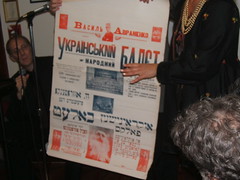 [She then shows off a poster of an early choreographer, Avramenko (sp?) in Yiddish and Ukrainian from the 1920s.]
[She then shows off a poster of an early choreographer, Avramenko (sp?) in Yiddish and Ukrainian from the 1920s.]
[It turns out that several Ukrainian AND Jewish films were done in New Jersey at the same site wwith the same sets]
Dmitri: My parents come from an area of Greece where dances are very structured.
For now, I am going to show you some examples of how the Greeks do a particular dance "hassapikos".
[video examples, "stamma" (freestyle), then some guys dance six-step pattern]
What is interesting is that this is a dance that is pervasive in Greece, so it is a Greek dance—we may not have invented it, but it is now Greek. But then there is something we call "asabik serbico"—we aren't necessarily calling it Serbian, as opposed to "foreign."
[Zev: from the point of view of a Greek in Istanbul, the Jewish and Rom music is "from there—serbian—foreign and northern]
[Dmitri and Zev talk about various Ottoman-era combinations between Greeks and Jews]
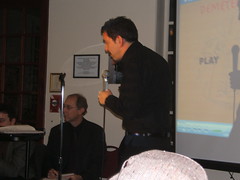 [Dmitri shows several clips ranging from a specific island and guys who have been dancing together for years and how their dancing has gotten complex and stylized, to women dancing without music—accompanied only their own singing—they say they don't need musicians, but they probably weren't allowed the resources to afford them, to a clip of men singing and dancing together in a line.]
[Dmitri shows several clips ranging from a specific island and guys who have been dancing together for years and how their dancing has gotten complex and stylized, to women dancing without music—accompanied only their own singing—they say they don't need musicians, but they probably weren't allowed the resources to afford them, to a clip of men singing and dancing together in a line.]
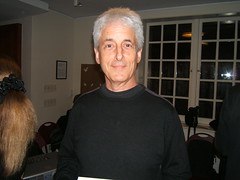 Erik: I had a general question with regard to co-territoriality. Why did Jews select some patterns and not others. This is like a soup with certain ingredients. For instance, a pattern in freilakhs and kolomeika and Byelorusian karahod—the pattern of alternation of a ring, and then solo items that occur in the middle. It's sort of unique to Ukrainian and Jewish/Byelorusian/Russian where this fluidity exists.
Erik: I had a general question with regard to co-territoriality. Why did Jews select some patterns and not others. This is like a soup with certain ingredients. For instance, a pattern in freilakhs and kolomeika and Byelorusian karahod—the pattern of alternation of a ring, and then solo items that occur in the middle. It's sort of unique to Ukrainian and Jewish/Byelorusian/Russian where this fluidity exists.
I was talking with [Eric Hines?] who said that in central Russia matriarchial patterns like the enclosing circle are common. This is different, say, from the Ukrainian styles that have a more macho style as in Ukrainian dance. So, there is an interesting question fo the interplay between Yiddish and Cossack dance traditions. Like, where does the Kazatcki come from? Cossacki?
Irka: For Ukrainians, this question of kazatzki and Cossacki is bothersome. It's ours. The kozatski traditions come from central Ukraine. The Kozatski steps were male, very macho show-off steps and the original hopak was done by Kozatskia before they went out to war, like a big frat club. They are very Ukrainian traditions. On the other hand, the Horavod (what I wrote earlier as "karahod") is a women's dance. But it is also in everyone else's culture. The women were the matriarchs. They sang.
Erik: I see these side-to-side, almost wobble that I saw with Ben Bayzler and Bronya Sakina, and I wonder if that is in other cultures. For instance, on the Bulgarian northeastern coast where there is something similar. Is there common movement vocabulary going on there?
Zev: Actually, I used to study that stuff. My hunch is that there is no connection. What he (Ben Bayzler) does is generated by Jewish gestures taken to an extreme. Whereas on the Black Sea, they come from anotehr place, and relate to the music differently. What Michael mentioned about the Crimean tatar women—I think there may be some connection.
There is a reference in 1674 there is a record of dancers, where Jewish dancers at this event are listed as Eastern people like gypsies, karaites, and turks—the 'oriental' or eastern minorities. So there may be some very ancient connections.
Michael: I think there is some kind of relationship between Black Sea people and movement.
Zev: I reject that.
BKG: Let's move on.
Erik: Something we have not touched on very much, but is a whole other area to look at is connection to Romanian folk dance. It would be interesting to find out more. I particularly have questions about honga and to where it connects beyond Bassarabia. Then we have an extended discussion about what are called "Terkisher" which happens in the klezmer repertoire and it isn't clear if it was a dance, and if so, what. Finally, there ianother whole category of dances that seeped into the Yiddish repertoire stemming from Russian couple dances. Something interesting in that tradition is that it became unpopular in the USSR but remained preserved in emigre Russian and Jewish communities.
BKG: Zev will wrap this panel up—we're a bit challenged for time
Zev: On the outside, we clearly need another conference just on the co-territorial issue. It is important to distinguish between an item—a whole dance—and a movement. Some things we see in co-territorial material where there appears to be a connection, and this is a different question than considering an "item." if there is an "item," it is usually more recent (which is what makes the sher unique).
Greek connections … our bulgar has a function within the dance tradition that is different from the way it serves in Greek culture.
Moldova—Moldavian dance has a special position in Yiddish dance repertoire. Strong influence on music—starts in Besarabia, diffuses to Ukraine and Galicia and idffuses not just to Jews, but to non-Jews. This is outside of Bukovina is historical Moldavia, but Podolya, which is not traditional Moldavia is different. Some of the spread may have happened in American Jewish culture. There is usual order to the dances.
Dave Tarras had both Jewish and Moldavian tunes to the same dance.
[Interesting differences in the ways that Zev and LeeEllen, the academics, speak compared to traditional, but non-academic practioners, from Michael and Steve, to Irka and Dmitri.]
BKG: How do you study co-territoriality? I think we need to look at the atlas of Jewish co-territoriality. But it is also different for Jews, than for people who are rooted in specific territories. Also, who are the communicators? Musicians? Next question: Emulators? Fashion leaders? Who are the tastemakers? Lastly, a lot of what we know of live dance is from older people who are teaching people who know nothing, and this may not reflect what the dance would look like in other circumstances.
Hasidic Dance
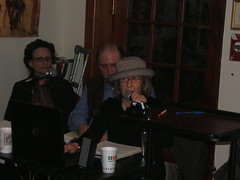 Jill: Will be speaking about Bobov, Lubavitch, Satmar, all of which are now based in New York, but come from different places in Europe.
Jill: Will be speaking about Bobov, Lubavitch, Satmar, all of which are now based in New York, but come from different places in Europe.
Who owns Hasidic Dance and how do we define it?
Like Yiddish culture itself, Hasidic Dance has many faces. Who calls Hasidic Dance what is a matter of ongoing debate in Hasidic culture. Potential definitions of the term include
- All dance practicie in Hasidic society
- Any dance performed in Hasidic style
- Distinctive Hasidic contant or dance form
- Dance criteria judged by Hasidim
In late 18th century, misnagdim excommunicated Hasidim. Among other things, there were Hasidic dance contests. And in anti-hasidic tracts, somersaulting was criticized. Only some circles of Hasidim adopted this behaivor.
[Jill shows broyges tantz on both women's sides and men's sides. Very different steps and activity to same tune.]
[Jill also shows us samples of various types of Hasidic dance, then goes back in history to writings even at the time of the Besht about the importance of dance.]
Relgious folklore was romanticized as "authentic" Judaism in prominent Yiddish writers, and in plays such as "the Dybbuk".
[Gradually we move on to a Satmar wedding in 1975 where the kabalas panim for the bride includes stylized gestures showing what the brides new duties will be—taking care of the babies, cooking, etc.]
[Jill walks us through examples of various traditional dances in hasidic weddings and other celebrations—notably, some interesting footage of the ceremony celebrating the completion of a new sefer torah in Jamaica Estates, Queens.]
NYC's ultra-orthodox community has become the epicenter of the Jewish ultra-orthodox diaspora. Court traditions from Eastern europe are foregrounded by the Holocaust. In an American context, dance appears to be frozen, perpetuating a memory that Hitler tried to extinguish. This public face is consider "authentic Judaism". But the public face is not the whole picture. there is diversity and a dynamic nature to hasidic dance.
Today, we might as well ask not what hasidic dance has contributed to yiddish dance, but rather, what has yiddish dance contributed to hasidic dance.
Concluding Remark
Michael: Thank you
[conclusion in some haste as, despite attempts to hurry, we have gone over, and need to get to the Ukrainian East Village Restaurant for a big, wonderful dance party that went on past 10pm.]
More clips from the evening dance.
Yiddish Dance Network—Planning Session
After the symposium on Sunday, academics, dance teachers, and other interested parties met on Monday to discuss how to move forward. Greatly miscalculating the time it takes to come from New Jersey to NYC, and even more, to find a parking space on a regular Monday morning, I arrived over an hour late.
One outcome of the planning session was the establishment of an information "Yiddish Dance Planning Network." A wiki has been established with full meeting notes from Judith Brin Ingber, as well as other links, discussion, and documents. Contact Pete Rushefsky at the Center for Traditional Music and Dance for further info.
Teaching Yiddish Dance
Tail end of discussion—see above for my excuses for arriving so late.
Erik: … need more teachers and dance leaders and more women in the field Shows DVD of Yiddish dance plus steps, background, created at Weimar last year We have to start somewhere. [can get DVD through Yiddish Summer Weimar for preliminary version. For more details, see Helen Winkler's 'Yiddish Dance' website]
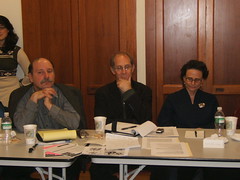 Zev: we need to be thinking on two separate tracks. We can't control how dance will be taught, appropriated. It is important that there be a certain movement to do something, to encourage that movement to take place—even to use techniques that the Israeli dance movement has done successfully. But then some of the value of Yiddish Dance and research will be lost. So, separately, there has to be a research track. These will not appeal necessarily to the same audiences or be done by the same people.
Zev: we need to be thinking on two separate tracks. We can't control how dance will be taught, appropriated. It is important that there be a certain movement to do something, to encourage that movement to take place—even to use techniques that the Israeli dance movement has done successfully. But then some of the value of Yiddish Dance and research will be lost. So, separately, there has to be a research track. These will not appeal necessarily to the same audiences or be done by the same people.
Steve: in terms of identifying audience, maybe even in america not all of our audience will be jewish. One thing I've noticed even in the folk dance circles, which tend to be insular, but there are also swing dancers and latin dancers who would get the social and improvisational nature of this. We're dealing on the one hand with a traditional culture. But we also have music that is post-traditional that has a great deal of interest to young people, but you can't do traditional dance to this new music.
LeeEllen/Michael: there is a lot of very serious work, there are people who play klezmer music in a "revitalized" way—this is the classic and historic conflict in Jewish life—klezmorim as playing music for listening and also being hired to play for dancing.
LeeEllen: one of the keys to looking across these two big areas is that there aren't going to be enough resources or funding to the various orgs to do it separately. One of the things to look at it are examples of success in revitalization movements—one good example, in the arts, is the country dance society—which has built a modest, but dedicated infrastructure, now based in Amherst. The point is that, that's an example where they have a lot of experience with what works and what doesn't, with working with bupkis, the dance/music issues of getting insurance, including having established a dance archive at UNH. Talking about classificaiton and revitalization I have written a bit about it. Another example would be the klezmer music revival. There has been a great progression in terms of ability—you need the best musicians for dancing, not who is avialable.
 … I think that, and this is a little bit of politics, there is some potential, and there may only be one opportunity to go after this for funding, levels of funding in other areas are just so massively larger. I think there is an opportunity to think larger, but not if every well-intentioned Tom, Dic, and Harry goes off in another direction. There needs to be a collaborative effort. Already the major themes have started to come out here. There is some potential with something that is coordinated with an eye to what is actually being funded…. There is actually a lot of interesting things to talk about with regards to revitalization movements. Not just regarding Jewish culture, but it's a theme that could be of great interest to funders.
… I think that, and this is a little bit of politics, there is some potential, and there may only be one opportunity to go after this for funding, levels of funding in other areas are just so massively larger. I think there is an opportunity to think larger, but not if every well-intentioned Tom, Dic, and Harry goes off in another direction. There needs to be a collaborative effort. Already the major themes have started to come out here. There is some potential with something that is coordinated with an eye to what is actually being funded…. There is actually a lot of interesting things to talk about with regards to revitalization movements. Not just regarding Jewish culture, but it's a theme that could be of great interest to funders.
You're not talking about dancing only, you're also talking about community groups, socoal context.
Steve: maybe we can divide up and each look at different revitalizaiton movements using the same questions, etc.
Zev: the key issue is that in most revitalization movements, the culture represents a country. Our problem is that most Jews do not think that this art represents them.
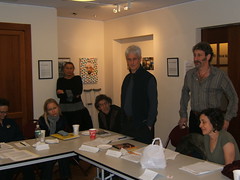 Helen: I've recently had an experience of teaching to Israeli dance teachers. And they looked like they were having a lot of fun and then they turned around and said "can we move on to something a bit uptempo?" I am constantly asked to teach Israeli dance, and I have to forge my own path. People in Toronto are shy of dancing. There are other social issues to consider.
Helen: I've recently had an experience of teaching to Israeli dance teachers. And they looked like they were having a lot of fun and then they turned around and said "can we move on to something a bit uptempo?" I am constantly asked to teach Israeli dance, and I have to forge my own path. People in Toronto are shy of dancing. There are other social issues to consider.
Dobe Ressler: I think that people don't know that Yiddish dance exists and that's why they don't ask for it.
Daniel Lang/Levitsky: what younger folks see as representing Yiddish culture is music. The culture that is taught as Jewish culture is basically Israeli or Israeli-centered. We have to take what Helen said seriously and not focus on the fight within Jewish instititons between Ashkenazi and Israeli. There are lots of people interested in Jewish culture who have no interest in those worlds. Think, for instance, fo the Balkan music culture or street brass movements, when those folks go home they play bluegrass and they play klez, but nobody knows how to dance to them.
Regarding post-traditional culture, as important as both of the streams that Zev spoke to are, it's what happens in between that makes for a living culture. How do we create a Jewish culture that relates to Josh Dolgin's music [mangled typing].
Michael: We've seen crazes and modes and different dance/music forms that have come and gone. To what extent are we interested in revitalizing older forms and to what extent are we interested in addressing newer forms that are very danceable. This is the "sher" of its time. To what extent do we as people embrace and adapt to that or find some happy medium?
Zev: Recently I taught a close that happened to be half african-american women. And they had no problem relating to movement. We didn't have to change the rheythm or tempo. If we have integrity about what we are doing we will attract people of many cultures.
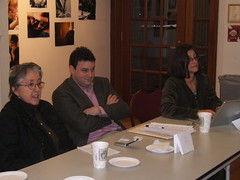 Judith Brin Ingber: As someone who has had to make her own way as a performer and a leader. I agree with LeeEllen that we need a concerted effort. And one of those efforts has to be with sponsors for cultural events…. For example, you have block bookings by the JCC cultural arts people. They don't want a business card, they want a business card and they want young people presenting to them at the block booking place. I got hired to do a class on Dance 101 and I insisted on space to dance and he said, no, can't do that. We have major education to do about this. It's part of the big picture thing that LeeEllen is talking about. If we can't find a way to package we're left out fo the Jewish education stuff in lots of place.
Judith Brin Ingber: As someone who has had to make her own way as a performer and a leader. I agree with LeeEllen that we need a concerted effort. And one of those efforts has to be with sponsors for cultural events…. For example, you have block bookings by the JCC cultural arts people. They don't want a business card, they want a business card and they want young people presenting to them at the block booking place. I got hired to do a class on Dance 101 and I insisted on space to dance and he said, no, can't do that. We have major education to do about this. It's part of the big picture thing that LeeEllen is talking about. If we can't find a way to package we're left out fo the Jewish education stuff in lots of place.
LeeEllen: we should have not just classes, but targeted master classes.
Field Research Documentation
General comments: Maybe we should submit resources by email. Helen's website!Irka: the Uktrainian dance community has a very sophisticated, sophisticated way of addressing the issues of revitalization and getting grants, etc.
Zev: we have to get younger people involved to do legwork—volunteers, interns, to document older experts now. It may be the sad truth that nobody's wedding video ever included a well-done sher. But we haven't really made a serious effort so far to locate that stuff. Through Jonathan Boyarin there was a suggestion to reach a wedding filmer who worked with Brooklyn hasidic weddings in the 50s and 60s.
Judith: what about this person whose case Helen has brought up? Who is going to tape this person?
???: I think it can be extremely helpful to put together a forum or panel at the American Folklore conference, at the SEM conference, and these are places where young scholars will meet us. Kay Turner at the Brooklyn Arts Council who has feet in both community and academic worlds. That's one way to do it. And she has a grant.
Steve: proposed:
- compile a list that documents areas of research with some sense of resources needed.
- Standardized questions for certain areas. If we don't make that list today, a deadline and soemeone to ensure that it happens
Zev, Michael: seconded
Irka: some of the questions you have, we have done these kind of programs in Ukraine. I was listening yesterday to some of the presentations. In Ukraine they have done lots of research on co-territorial issues. These dance seminars are very popular. I have taken many dance ensembles to Ukraine for various finding your roots, historical, etc. purposes. Until you go out there in the field and feel those influences you aren't going to be getting anywhere. Going from Poland to Romania to the Carpathian mountains…. [but haven't folks like Michael and others have done lots of that? ari]
Michael: it is good to get a sense o fwhat culture is like there now, but for Jews, many of these places never exist.
Zev: To what degree can Israel play a role? In some cases there can be better access to some people there. Maybe we should apply to the Avikhai Foundation which is a large organization. It may be worth seeing this as an international project
Michael: Avikhai (sp? full name?) is especially active in culture in eastern europe
Zev: about Eastern Europe, the old homeland. The first word out of some funders is "FSU" (former soviet union), but we have to be very focused about what we have to learn from that. We don't have Jewish populations there with the numbers and culture that existed a century ago.
Steve: who is "we". Who is applying, who is deciding, who is recording, who is disseminating.
LeeEllen: Right now we're planning. Are there quickie funds from states arts councils to get travel funds to bring people together and work these things out? How do we get started?
Hankus Netsky: [? from Indiana ethnographic expedition] does that include dance?
I do want to say that there is SEM and AHS, but there is also AJS—there are more Jewish Music presentations at AJS than the last year of SEM combined. There is an ethnographic expedition, rather well funded, to Poland and Ukraine. This is an expedition supposedly to gather what is left of Yiddish language and folklore in those countries.
Michael: Dov Ber ____ and ___ Widlinger? Since Perestroika there have been a lot of systematic expeditions, mainly out of St. Petersburg, which have been going to many areas in the FSU and border areas. Unfortunately, until recently, their focus has been on language and culture, but not music and dance. There is also research being done out of Minsk.
Judith: new director of NFJC is a dancer.
Pete Rushefsky: I'm interested in your idea, Hankus, in training people to do fieldwork. Mark Kligman has done a class on fieldwork at KlezKamp.
Hankus: this is very different. It may very well be calling on the energy of people in this room … major grants.
Kids are learning all this stuff from Israel or 5000 years ago. Here's stuff that is happening here and I think they would be interested.
Michael: before we leave, we need to decide, maybe on a name, decide how we'll stay in touch.
LeeEllen: one of the political issues is that if there is something that can be done on the Canadian side that can build on what Helen has started and that would start to set the stage.
Steve: I can go home tonight and set up a Yahoo Group.
 Avia Moore: the Canadian thing is not to be ignored. Canadian funding is available to Canadian orgs. But they have Canadian content limitations. But then they can partner with US orgs. The thing about the website, I've been looking at that for 3 months for KlezKanada. I would really caution that as this gets created that there is a balance of gender and age.
Avia Moore: the Canadian thing is not to be ignored. Canadian funding is available to Canadian orgs. But they have Canadian content limitations. But then they can partner with US orgs. The thing about the website, I've been looking at that for 3 months for KlezKanada. I would really caution that as this gets created that there is a balance of gender and age.
Daniel: not of caution about some of the online stuff. The difference between an email list on yahoo vs. an actual website. Similar issues with MySpace.
Hankus: the book center is signing up with the open content alliance, but we're really trying to do with with whatever we can with music and other media as well.
LeeEllen: repository funding is another issue. It could be very neat to have NYBC involved as an anchor to this, but it should be up for discussion]
[hard to take notes as I try to figure out how much is to the question and what people are really jockeying to say/achieve for themselves]
Steve: archive a knowledgebase
research
disseminate
??: I think that's all a given. there are two orgs in position to go after funding [which two?]
Michael: Is the Center in a position to help coordinate
??: I'm suggesting a collaboration with NYBC
Michael: and to which I would add the Canadian piece
??: this has to happen and then we can coordinate w/Canadians
Erik: There was some talk of Josh Waletzky doing a film compilation of archival materials and doing some additional filming.
Michael: basically where we left it 6 years ago.
Pete: Josh is very interested, but it would take the right this and that … we are talking
Erik: so I have a plan. If we're possibly moving towards another event like this one but with more primary informants drawn in. Could our focus be to ensure that Josh could also film that event.
Hankus: I have a mini-event in Philly on Thursday that's like that. It will be filmed.
Pete: Should we start talking … there are many different sub-communities in American Jewish community, Israel, etc., would it make sense to identify some of them? Hasidic, Arbeiter Ring—where there might be informants. Is that worthwhile?
Judith: Can we first identify what will happen after 2pm this afternoon.
LeeEllen: It's clear that we need to find a way to stay in touch before we leave the room. Let's identify an ad hoc planning group, and a core with specific assignments. I have spent 20 years working on soft money. We have to think strategically and address the urgency of these issues as our respondents have advancing age [Michael—not to mention ourselves]. The next short-term priority needs to be to get sufficient funds to pay for travel to convene to go farther.
Pete: Let's just get a list of communities and then come up with some strategies
Michael: Hasidic world (worlds, even internationally—montreal, antwerp, israel)
Jill: and in terms of Israel, we have someone who is begging to help—let's go there
Zev: Hasidim in Montreal are one of the most traditional areas. If we could get funding for Montreal it's really urgent
Michael [getting back to list]: Former Soviet Union (although more than half of those Jews now live in America or Israel)—lots of segments of that … looking at archival and wedding video (family collections, national center for Jewish film, YIVO, American folk-life center)
Steve:don't forget to look at cities and regions
Michael: part of this can be putting out a call …
[more ideas]
Pete: Workman's Circle
Zev: Landsmanschaft are now burial societies
Hankus: Association of Yiddish Clubs
Judith: Association of Yiddish Vinkls
Daniel: Alumni networks of largely left, including Yiddish, summer camps— esp to talk to the alumni parents
Michael: Haim Kaufman—docs on dancers of the 1st generation
Judith: Tzvi Friedhofer's archives are now in Tel Aviv. Another person who has been left out of the conversation is Jacek Luminsky—has very interesting material in Poland that he gathered in the 70s through the 90s. He goes back and forth enough.
LeeEllen: these things get into real permissions issues
Asya: I interview Hasidic women, but I don't know anything about dance. If someone gives me a questionnaire, I can add those questions.
[further discussion of sources of archives, etc. Those who want more details should contact Pete Rushefsky for access to the Yiddish Dance Network wiki or for further info.]
So, we adjourned for lunch at a nearby cafe, and then I met my wife to drive down to Brooklyn for a wedding. The wedding was an ultra-orthodox affair, the sort of event where, once the dancing and dinner starting, men sat (and of course, danced) on one side, and women on the other. In this case there was a lot of permeability between the sides, especially when dancing wasn't happening. During the dancing, there would be periods when the bride and other women would burst into the men's area. In these cases, usually the bridge would be seated next to the groom and the traditional inner circle dances—the free-for-all dances to please and amuse the couple—would continue.
I paid some attention to both the music and the dance. The music was modern Israeli Orthodox—I detected no klezmer, or very little. What was especially of interest was that almost all of the music included singing—pizmonimand other sacred texts, as though to ensure that the music was inseparable from holiness and holy intent. Often the dancers sang along. The other issue was the dance steps. I suspect that some of them did come from Eastern Europe, although it wasn't clear to me in my general ignorance (I have had numerous opportunities; I just don't dance well enough or often enough to remember.). There were many kazatzkis and similar dances: this community now pays some attention to footwork (although the steps, themselves were not sophisticated; rather the theatrics and efforts were intense). Most of the action still appeared to take place above the waist, as is traditional, and I thought that I saw some of the gestures that Zev modeled for us the day before.
I concluded that Yiddish Dance as was practiced 100 years ago in Eastern Europe is largely gone, replaced by new traditions, and probably influenced greatly by Israeli fashions. And the music? When the band used heavy metal riffs to open each dance set, I think it is okay to acknowledge that it is not klezmer as I have ever encountered it. If the main Jewish communities that dance at simkhes no longer follow these traditions, it sets additional urgency on capturing the memories and steps of those who remember the old dances. And, of course, there are new dances to be learned!
